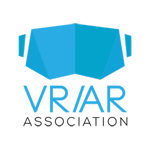Learn how to display products in 3D on your e-commerce website or app. Understand key stages in the 3D creation process, common challenges, and how to choose the best approach. See why 3D product images and models benefit businesses—and how the right partner leads to results.
Inside this article:
3D product images vs. 3D product models
A 3D product image is a static, rendered image given depth with lighting, shadows, and backgrounds. A 3D product model is an interactive representation of a product that shoppers can rotate and zoom. Both 3D product images and 3D models can help drive e-commerce sales.
The term 3D product image refers to a flat 2D image that is rendered from a 3D product to show one or many angles of the product. For example, many retailers invest in 3D models to create tools like product configurators, which let consumers customize products in real time. However, retailers may also be interested in using high-quality to show a variety of product angles or pre-configured combinations.
This article covers the methods to create both. They are closely related because 3D creators often create 3D product images from 3D product models. They turn models into lifelike pictures, adjusting lighting and backgrounds to create clear, high-quality visuals. For example, if a team created a 3D model of a couch and needed an image for an online or print catalog, they could render it from the model instead of setting up a traditional product photoshoot.
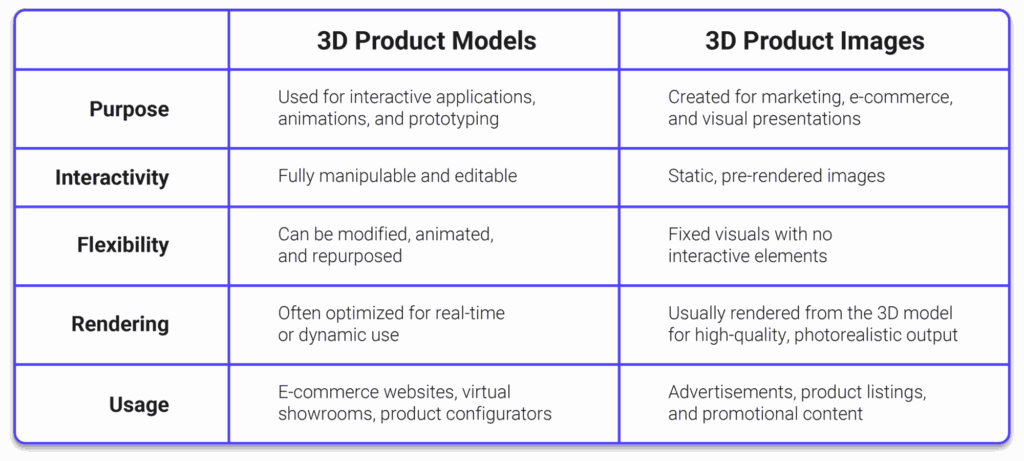
Example of 3D product model vs. 3D product image
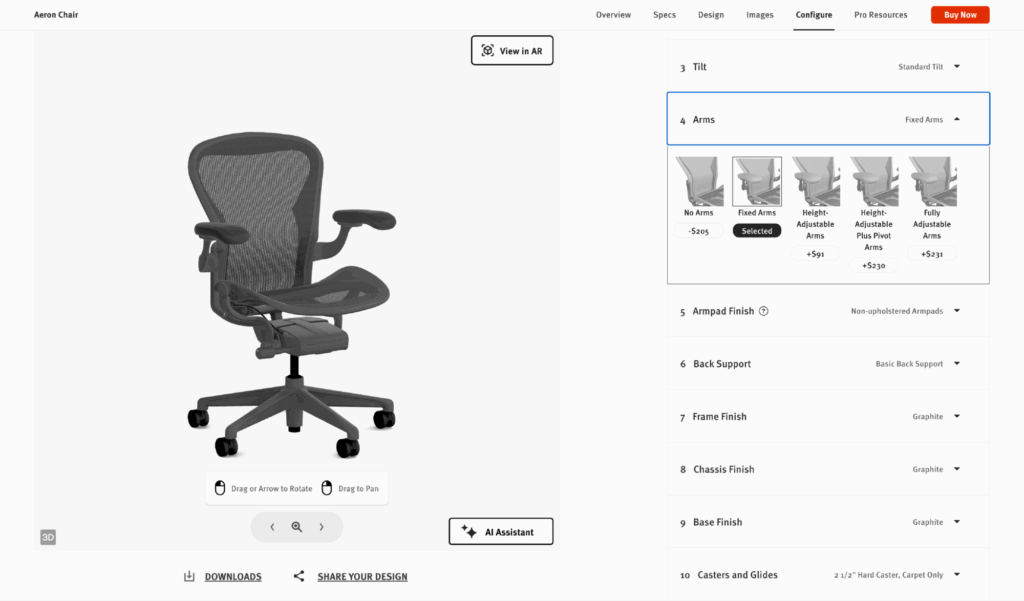

Key Takeaways:
- 3D modeling software is the most common method for creating 3D product models and images. 3D scanning, photogrammetry, procedural content for products such as kitchen cabinets or rugs, and AI have all made contributions to speeding up the product creation process.
- The combination of 3D product images (3D product renders) and 3D product models can help drive your e-commerce website or app.
- The major stages of 3D product model creation include defining project expectations, developing the model, adding details like textures, testing quality, and deploying it for use. You can use the models to create 3D product images.
- Generative AI is getting better at 3D model creation. AI can generate basic 3D models, reducing the time it takes to create finished models. Professionals often use AI-generated models as a starting point before refining them manually for higher quality.
- Outsourcing 3D model creation, QA, and 3D digital asset management to a reputable third party can streamline the process and ensure high-quality results.
Different methods to create 3D product models and images
The most common way of creating 3D product models to date has been by 3D artists using reference photos and recreating the product in 3D modeling software. Another common method is photogrammetry, which generates a model from multiple product photos. A 3D scanner can also scan the physical product and create a model. Creators can make a 3D product image from any 3D model. Also, AI is an increasingly popular approach to developing basic models that artists can refine to match the real product.
Different modeling methods offer distinct advantages, challenges, and ideal use cases, making choosing the right approach for each project important. Here’s a summary of the different methods to create 3D models:
1. 3D modeling software
- How it works:
With 3D modeling software, users can take reference material, usually images of the product, to create 3D models manually. For example, Blender, Autodesk products (like 3ds Max and Maya), SketchUp, and CAD (computer-aided design) software.Some 3D modeling software workflows rely on procedural modeling, which generates models using algorithms and rules rather than manual design. This method is useful for creating complex, repetitive structures like landscapes or intricate patterns. Other workflows use reference images or scans to guide the modeling process.

Andy Macy, Director of 3D Content at 3D Cloud
“To date, 3D modeling has been the most common approach to creating 3D assets,” says Andy Macy, Director of Content at 3D Cloud. He has over 25 years of experience in 3D modeling and visualization, spanning multiple roles, industries, and software packages.
“AI is getting better at producing 3d assets that reflect real products, but humans creating 3D models from reference imagery is still the best path to the most accurate 3D model. It may take more time than the other methods, but the result is higher quality, and clients demand high quality.”
- Pros:
- Offers a high degree of optimization
- Don’t need the physical product to generate a model
- Cons:
- Steep learning curve
- Expensive to outsource
- Most time-intensive
- Use cases:
- Whenever you need high-quality renders
- Models for mechanical engineering and automotive part applications
- Models for detailed and large products like furniture
2. Photogrammetry: 3D models from photos
- How it works:
Photogrammetry is a technique that creates a 3D model by analyzing multiple photographs of an object. To use it, the user must take at least 20 overlapping photos from various angles to fully capture the product. These images are then processed in photogrammetry software, which builds the 3D model by comparing pixel patterns across the different perspectives.The software calculates the relative positions of the images, determines depth information for each pixel, and generates a depth map. Using this data, it constructs a 3D mesh that represents the shape of the product.It can be easy to confuse photogrammetry with 360° product photography, but they serve different purposes. While 360° product photography captures multiple 2D images of a product to create a rotating 360° product image, photogrammetry processes multiple images to reconstruct a fully interactive 3D model that can be manipulated from any angle. Likewise, 3D photography shares similarities with photogrammetry, but doesn’t create a true 3D model. E-commerce photography refers to traditional product photography. - Pros:
- More affordable than most methods
- Faster turnaround time than 3D modeling software
- Cons:
- Requires precise photography; every image must have the same lighting, and the camera must be in the same relative position
- Not ideal for large objects or landscapes with changing elements
- Generally generates lower-quality models than scanning or 3D software
- Use Cases:
- Creating 3D models for small to mid-sized products
- Projects with a limited budget that don’t require a high-quality render
3. 3D scanning
- How it works:
A 3D scanner captures the physical shape and details of a product by scanning it from multiple angles. The scanner collects data on the geometry and texture needed to produce a 3D model. Different types of 3D scanners vary in precision and quality. Laser scanners are the most precise, while handheld or smartphone-based scanners may be less precise. The right 3D scanner for capturing a given product type depends on the size of the item and the quality model that the user needs. - Pros:
- Typically more accurate than photogrammetry, especially for detailed or complex shapes
- Can quickly generate a basic model
- Can better capture the details of complex designs
- Cons:
- Expensive, with costs varying based on scanner type and resolution
- Requires the physical product, so it can’t be used for items that haven’t been manufactured yet
- Generally less accurate than 3D modeling
- Can struggle with certain surfaces (e.g., transparent or reflective)
- Use cases:
- Creating e-commerce models for small, existing products
- Medical applications like prosthetics or modeling
- Digitizing physical objects for CGI and animation
- Scanning objects to obtain precise measurements for quality control and inspection
4. Hybrid (3D scanning + modeling software)
- How it works:
Hybrid modeling combines 3D scanning with traditional 3D modeling software. The process starts with a 3D scan of a physical object. Then, the user takes the scan and optimizes it in 3D modeling software. - Pros:
- Captures intricate details that manual modeling might miss, while using manual modeling to refine and optimize the end product
- Saves time by using a physical model instead of building from scratch
- Versatile to allow for realism and creative adjustments
- Ideal for complex shapes and highly detailed products
- Cons:
- Requires specialized equipment like scanners that are expensive and have a learning curve
- Processing high-resolution scans requires powerful hardware
- Use cases:
- Ideal for creating models for complex shapes
- Capturing real-world objects for refinement or 3D printing
- Digitizing existing items, like artifacts or products
- Medical applications
5. AI-powered 3D models:
- How it works:
Artificial intelligence (AI) tools use machine learning and neural networks to generate 3D models from references like 2D images or even text descriptions.They analyze the patterns in the data and predict missing details to create 3D models of the item. AI is improving all the time and one day most 3D product generation will include AI.
- Pros:
- Can generate models from limited input
- Easiest for beginners
- Speeds up workflow by creating a basic model quickly that an expert can refine
- Relatively inexpensive
- Cons:
- Results can vary in accuracy and quality, depending on the AI model and the input data
- AI technology is still developing. It can hallucinate (e.g., remove product details or add details that aren’t included in the real product), and final models might need manual adjustment from an expert
- May struggle with highly complex or unique objects without enough data
- High-quality AI tools have usage limits or are expensive
- Limited control over fine details
- Use cases:
- Generating 3D assets for games
- Generating 3D products that don’t need to be high-quality
- Ideal for creating quick prototypes that don’t need to be high quality
Ways to Create 3D Product Models and Images
Jeff Cowgill explains the general steps for 3D product models regardless of technology.
Alternative ways to create a 3D product image
While making 3D product images from 3D models may provide the best quality, there are other ways. These include AI-generated images, 2D image manual manipulation, and photogrammetry.
Here’s a closer look at these other ways to make a 3D product image:
- AI-generated 3D product images: Use AI-powered tools to generate a product image with a 3D look without needing a model. Some AI tools can turn 2D images into simulated 3D perspectives by adding lighting, shadows, and depth effects. This is generally best for quick concept visuals or marketing images without full 3D rendering.
- 2D image manual manipulation: Take a standard 2D product image and use Photoshop techniques like shadows and highlights to simulate depth. Techniques like perspective warping can be used to change viewing angles or gradient overlays can be used to mimic lighting effects. This is best for small edits and low-budget solutions.
- Photogrammetry without creating a full model: Use photogrammetry software to stitch multiple photos into a realistic 3D-looking image without exporting an interactive model to work with. This may be best if you don’t plan to use interactive 3D models.
Stages of 3D model creation
There are five stages to creating 3D product models. The team starts with discovery to define project expectations. During content creation and model building, they use references to develop the model. Next, they test its quality. In the activation stage, they deploy the final model.
Macy says the most effective way to create a 3D product model is by establishing a 3D content pipeline. This structured workflow guides the team from the initial concept to a fully optimized model ready for deployment. “A well-structured 3D content pipeline significantly improves both time efficiency and quality,” Macy says. “An inefficient pipeline can drastically increase the time and cost of creating a 3D model.”
Once the model is complete, the team can render different 3D product images, adjusting angles, lighting, and other details for marketing and e-commerce applications.

Jeff Cowgill, Chief of Staff & Executive Director, AI Strategy
Jeff Cowgill, 3D Cloud’s Chief of Staff & Executive Director, AI Strategy, next describes the five major stages when creating a 3D product model. While they are most relevant to software-based modeling, teams using other methods, such as 3D scanning, can adapt them to fit their workflow.
1. Discovery
In the discovery stage, the 3D modeling team collaborates with the client’s team to determine what type of 3D product model to create. The data team is also involved to ensure the model contains the right metadata so the product functions properly across all the client’s applications.
“The discovery method is the most important step,” Cowgill said. “It sets the expectations and criteria for the rest of the process.” The discovery phase is when the client submits reference images, which are the most important element for the 3D product team to build the model.
“The reference image is the most important part for the content creation team,” said “The team uses the reference image alongside the dimensions—the size of the product—to create the model.”
The image quality is crucial. “It should be at least 2K by 2K resolution so we can zoom in and capture details,” Cowgill said. “While one image can work, having more is better—like a front view and a back view. The more reference imagery we have, the better, especially for products with repeating patterns.”
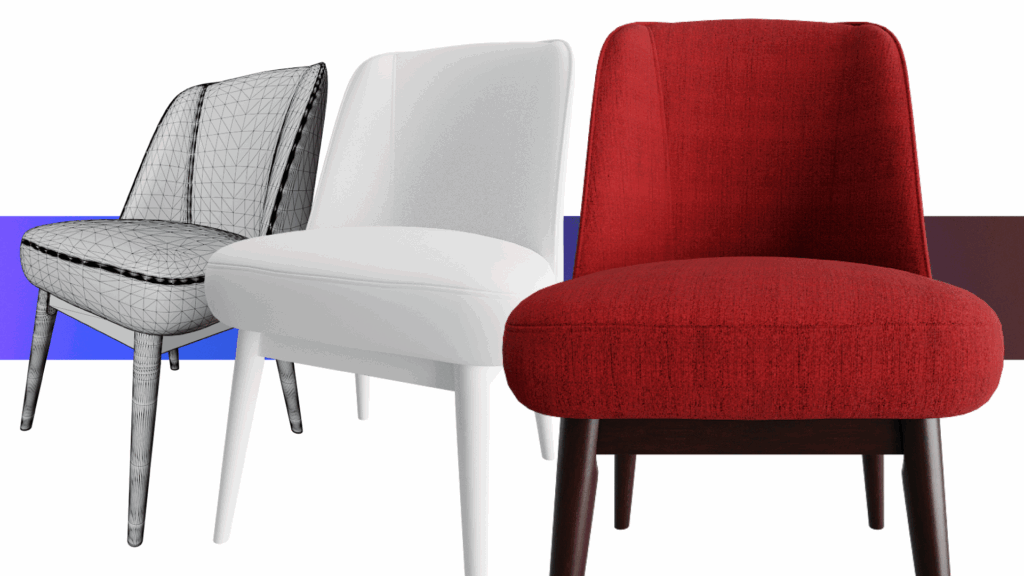
2. Content creation
During content creation, the team breaks the product model down into its basic components—geometry and meshes—which form the 3D model’s structure.
The geometry defines the overall shape and structure of the model, while the mesh is the network of polygons that make up its surface. Cowgill explains that most 3D teams include specialized art teams responsible for creating materials—such as textures—that give the product its distinct look, like the grain of wood or the sheen of metal.
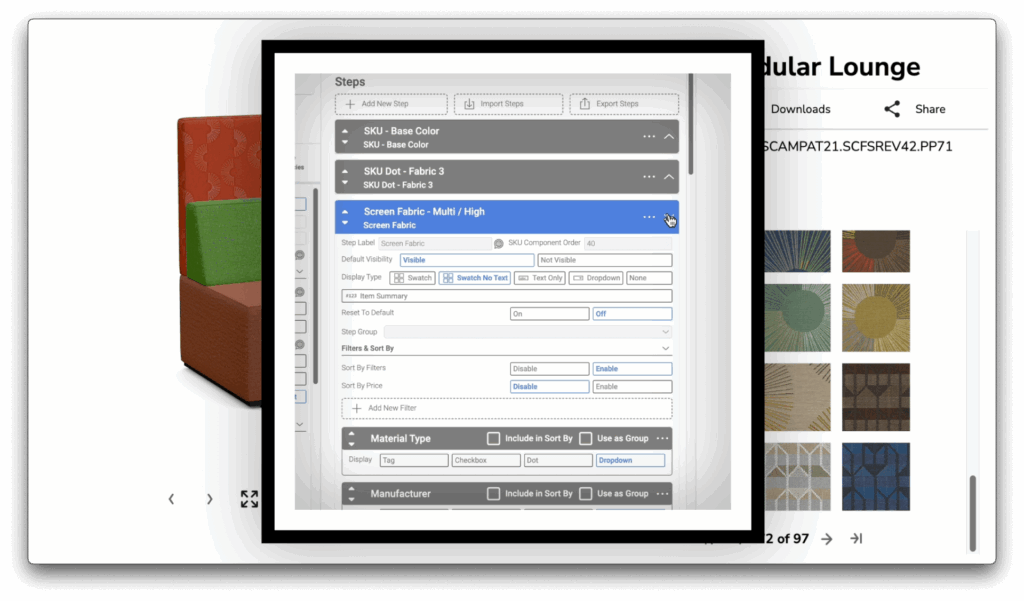
3. 3D product model building
“All the parts come together in 3D product building where we apply materials and textures to the meshes,” Cowgill says. He notes that creators use the term 3D products to refer to 3D product models.
This is also when data-driven business rules are added to the 3D digital asset management system hosting the 3D products. The business rules determine how a given model will behave in different environments. At the end of this phase, there is an initial iteration or draft of the complete 3D product model.
4. Test and Remediation (Quality Assurance)
In quality assurance, the 3D model is tested in applications that simulate its intended use, such as within a 3D room planner, WebAR, a 3D configurator, or for 2D product renders. This process ensures the metadata is correct and the model functions properly within a given The test and remediation process can reveal whether a model presents and behaves as expected in each application and is linked to a relevant to the correct product page.
“Without built-in quality testing, the final model may be subpar and incompatible with various applications,” explains Macy. “This issue often leads to multiple rounds of remediation, further driving up costs and causing unexpected delays.”
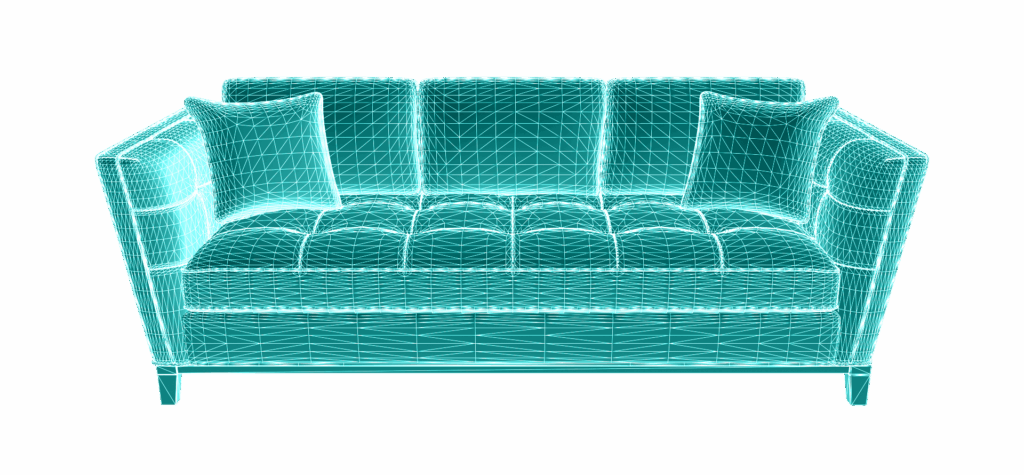
5. Push to production
The final step is deploying the product model into the client’s production environment, where customers can interact with and use it. Before that, most clients test the product model in a staging environment to ensure the model interacts properly with the system. Once approved, the 3D product model is published to live.
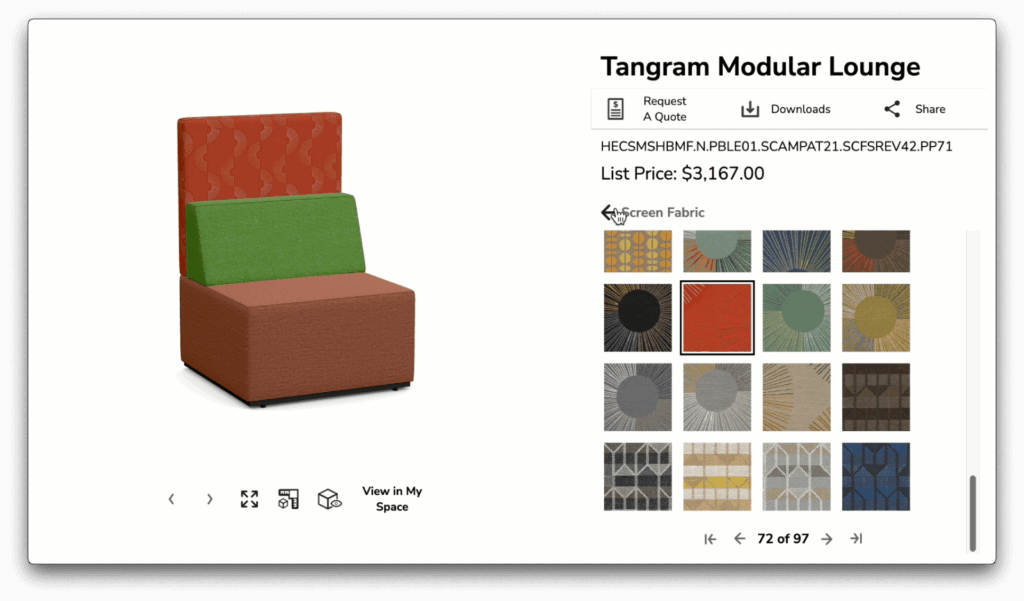
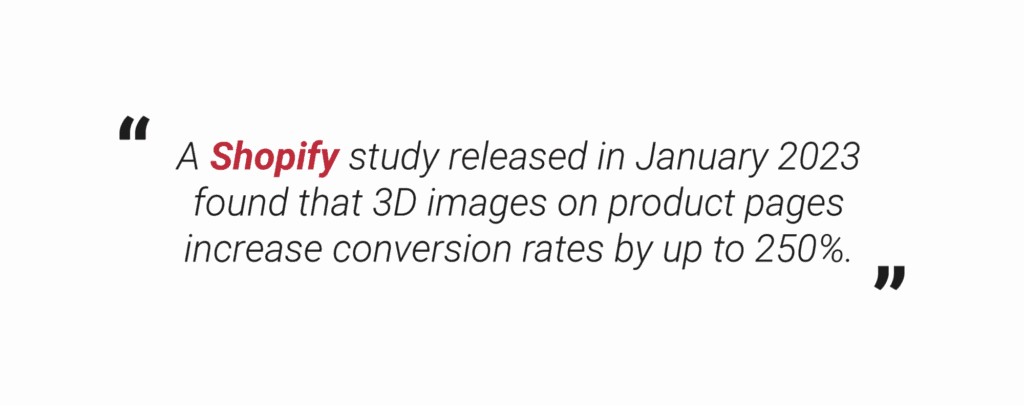 The role of AI in creating 3D product models and images
The role of AI in creating 3D product models and images
AI streamlines the process of creating 3D product models to help teams produce high-quality assets more efficiently. AI tools can quickly generate an initial 3D asset and give teams a solid starting point. Then, 3D artists refine and finalize the model.

Jessica Tawade, Director of Engineering at Common Sense Machines
Jessica Tawade, the Director of Engineering at Common Sense Machines (CSM.ai), says that 3D generative AI models are already speeding up the 3D product workflow. Since 2022, she has led the development of AI-driven 3D asset creation tools at CSM, including one of the first commercial AI image-to-3D product model platforms.
“3D generative AI is significantly accelerating 3D product rendering,” she explains. “Tools like AI image-to-3D can generate assets in minutes, providing designers with a strong starting point rather than having to model everything from scratch. This allows them to refine and enhance these AI-generated assets and reach production-level quality faster.”
Tawade also points out that AI can help designers generate multiple assets at a time. “The speed at which AI can generate multiple assets enables designers to iterate quickly, edit models, and assemble entire scenes for rendering,” she explains. “What once took hours or even days to manually create can now be achieved in a fraction of the time, streamlining the overall workflow and making 3D product visualization more efficient.”
Looking ahead, Tawade expects AI to further refine and optimize the 3D design process. “AI is set to bring significant changes to 3D design workflows by automating the more monotonous and labor-intensive stages of the process. Retopology, UV unwrapping, and even initial model generation will soon be streamlined with AI-powered tools, allowing artists and designers to focus more on the creative aspects they enjoy,” she said.
These innovations will lower costs and remove barriers to entry in the 3D space. Tawade predicts that AI will enable more companies to be able to create 3D products. “By speeding up workflows and automating certain tasks, AI can help reduce production costs. With faster asset creation and rendering, designers can accomplish more in less time, allowing for greater flexibility and accessibility in high-quality 3D visualization.”
Challenges of creating 3D product models
There are several challenges when it comes to creating 3D product models. The most common challenges include finding accurate product references and ensuring that associated product metadata is clean and aligns to the 3D models. It can also be difficult to make a 3D product reflect the details, materials, repeating patterns, and textures of the real-world product and to make the 3D product look realistic. It’s also important to ensure that 3D products are usable across applications such as 3D room planners, WebAR, and 3d product configurators as each comes with unique requirements.
From sourcing the right reference materials to ensuring seamless integration with e-commerce platforms, every step of the process requires careful planning and investment. Here’s a summary of the challenges of creating 3D product models:
- Getting the right reference material
According to Cowgill, one of the biggest challenges arises at the start of the process. “One of the biggest challenges with clients is ensuring that they source the relevant people during the discovery process to get us the right reference imagery and any metadata that goes with it.”Reference materials such as product photos, technical drawings, or physical samples are the foundation of 3D modeling. 3D artists (and even AI tools) rely on visual references to create an accurate digital version of a product. Poor-quality, incomplete, or inconsistent references can lead to models that don’t match the actual product and result in time-consuming revisions. - High cost and time demands
For now, creating high-quality 3D models requires specialized software and skilled professionals. Whether you’re outsourcing your 3D projects or building an in-house team, the process can be resource intensive. AI is changing how 3D products are created and is expected to significantly shorten the time and skill it takes to create new 3D models. - Connecting 3D models to accurate product data
For a 3D model to be configurable, it must be tied to accurate product data, like pricing, dimensions, color, and customization options. If the product metadata is outdated or inconsistent, the digital model may not match the real product, which can lead to disappointed customers. - Building reusable 3D assets
To get the most out of a 3D content investment and ensure consistency throughout a product catalog and across 3D experiences, retailers and manufacturers often build 3D products with reuse in mind. This means that they create textures (e.g., glass, wood, metals, upholstery, proprietary materials, and building materials showing details like cracks, grain, and scratches) and meshes or geometries (the actual 3D shape of an object) that can be componentized and used across multiple products. Materials need to look realistic under different lighting conditions, and shared geometries must work across different product variations. For example, a furniture company may apply the same wood texture or metal frame to multiple designs, but ensuring they look good in every configuration requires careful planning. Efficient asset management and well-organized libraries help reduce redundant work while maintaining visual consistency. - Creating realistic products
Creating realistic 3D models requires the right combination of lighting, textures, shading, and rendering techniques. Adding elements like imperfections, reflection, roughness, and transparency can be difficult, but are important to make the 3D model look convincing and photorealistic. - Optimizing for web performance
Even the highest-quality 3D models won’t be effective if they negatively impact the user experience. Studies show that even a 1-second delay in page load time can lead to high abandonment and cost a retailer millions of dollars in sales. 40% of shoppers will abandon a website if it takes longer than three seconds to fully load. Optimizing 3D assets for performance is essential for maintaining fast load times without sacrificing visual quality. - Ensuring all configurable product variations are available and accurate
If a customer can configure a product, business rules should drive the configurations, ensuring that only available, buyable combinations can be configured and that configurations are priced accurately and available for sale.
ROI on creating 3D product images and 3D product models
Investing in 3D product images and models can deliver strong ROI. A comprehensive 3D content strategy can reduce friction in the sales process, increase customer engagement and loyalty, and reduce returns. High-quality visuals enhance the shopping experience and make customers more likely to buy.
Experts project the 3D rendering and modeling market to grow from $4.54 billion in 2024 to $23.78 billion by 2034, highlighting the potential of 3D e-commerce. Many e-commerce businesses are catching onto the potential benefits of this technology and are seeing a positive return on their investment (ROI).
Here are key ways 3D product images and models contribute to a positive ROI, as part of a comprehensive 3D content strategy:
Increases conversions
Conversion rate is one of the most important metrics in determining ROI. Retail technologies that turn browsers into buyers are hard to ignore. Studies consistently show that 3D product visuals give customers a complete and realistic view of configured products, which can make them more confident to purchase. For example, 3D product configurators help customers visualize products from different angles, and allow them to add customizations such as different components, colors, materials, and finishes.
- 3D models increase conversion rates
- A Shopify study released in January 2023 found that 3D models on product pages increase conversion rates by up to 250%.
- Consumers like the experience of shopping with 3D products
- According to the , 94% of shoppers say it’s important to view images of the exact product to buy in the exact colors, patterns, sizes, etc.
- More than three-quarters feel that using 3D visualization or 3D product configuration makes them better at buying furniture.
- Academic insights: Researchers have identified key elements in 3D product images that improve the shopping experience and make shoppers more likely to buy.
- Size perception and weight
- In digital environments, where shoppers can’t physically interact with products, 3D images can influence their perception of quality. In a 2024 study, 3D versus 2D: Effects of the number of dimensions of product images on perceptions of product size, published in the Journal of Consumer Behaviour, researchers report that 3D visuals can make products appear larger or heavier—a key advantage for categories like food, where weight often signals higher quality.
- Case studies
- Jerome’s Furniture partnered with 3D Cloud to introduce a WebAR feature, allowing customers to visualize products in their own spaces using mobile devices.

- Jerome’s Furniture partnered with 3D Cloud to introduce a WebAR feature, allowing customers to visualize products in their own spaces using mobile devices.
Increase average order values
3D product visualization can significantly increase average order value (AOV) by improving customer confidence and encouraging them to customize products. When shoppers can interact with a detailed, realistic 3D model, they gain a better understanding of the product’s quality, scale, and features—leading them to choose premium options, add complementary items, or buy in larger quantities.
For example, Macy’s partnered with 3D Cloud to implement 3D room planners featuring the patented “Design from Photo” feature.
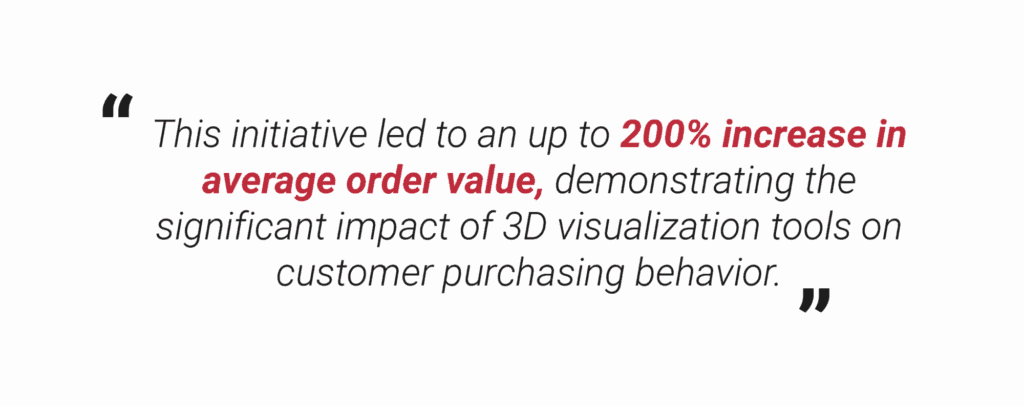
The Bain & Company report “Making it personal: Rules for success in product customization” showed that customers are willing to spend 20% more for a customized product than for the standard version.
- Increase brand loyalty with a better customer experience
Beyond a single sale, 3D product images help build long-term customer trust and loyalty. Modern consumers expect immersive, interactive shopping experiences. Brands that offer 3D e-commerce and AR tools position themselves as innovative and customer-focused. According to the 3D Cloud Furniture Shopping Trends Study, 2025, nearly half of survey respondents prefer shopping at retailers that offer 3D configurators.
- Reduce returns
Returns are a growing problem for retailers, especially retailers of large scale or highly configurable products that are difficult to reshelve and resell. In December 2024, NRF projected that 2024 retail returns would amount to $890M in merchandise value with consumers sending back about 16.9% of purchases. Return rates for online purchases are 21% higher than for goods purchased within a store.Reducing returns presents a major cost-saving opportunity. 3D product images give customers a clearer, more accurate view of products, which helps them feel more confident in their purchases and ensures they receive what they expect. Since 2018, Shopify partner success stories have reported a 40% reduction in returns by offering 3D products and product renderings on product pages. - Potential for more effective marketing
3D product renders enhance the customer experience and offer major operational advantages, including streamlining product merchandising imagery and ordering for large catalogs of highly configurable products. After creating a 3D model, retailers can capture the product from multiple angles, a wide range of backgrounds or localized contexts, and an assortment of lighting conditions, all without on-site photography. This flexibility enables faster product launches and marketing campaigns.
Expert tips on choosing your 3D product model/image creation method
Choosing the right method for creating 3D product models and images depends on the catalog size and configurability, accuracy, use cases, timeline, available product references, budget, and team expertise. Experts recommend looking at the whole picture, budget, and more to find the right method.
Depending on priorities, there are several options for creating 3D products at scale. Here’s a quick overview of the most common:
- 3D software modeling: Best for high accuracy and control over details, ideal for marketing materials and interactive applications.
- 3D scanning/photogrammetry: Works well when a physical product is available and realism is the top priority.
- AI generation: Fast and affordable, but less accurate. Requires a human in the loop to avoid hallucination errors.
Choosing which method depends on a variety of factors like how you plan to utilize a given 3D product catalog, your timeline, budget, and more.
Here’s what to consider:
- Catalog size: Smaller catalogs (less than 500 SKUs) or catalogs of non-configurable products or product lines that are static over time can benefit from a one-off modeling approach and assets may not need to be managed through a dedicated 3D digital asset management system. Enterprise catalogs with 500+ product SKUs or highly configurable products need a full 3D content strategy and should be handled through a 3D digital asset management platform.
- Accuracy:
Macy emphasizes the importance of asking, “How close does the 3D model need to be to the physical product?” If the model must be highly precise—such as for product prototyping or integration into applications—a detailed modeling approach is essential. However, if some artistic interpretation is acceptable, a lower-accuracy model may work. - Use cases:
Clarifying use cases for the 3D products, and whether you plan to reuse the model across applications, helps determine whether a high-accuracy method makes sense or if a lower-quality approach will suffice. “If your products will be used in high-resolution renders, you’ll need high-quality models and materials,” Macy says. He added, “If a 3D product will be used in assemblies with other 3D products in an application such as a 3D product configurator, 3D room planner or 3D modular or sectional configurator, accurate dimensions and product data will be very important.” - Timeline:
Macy notes that 3D modeling is the best way to create precise, accurate models, but it is also one of the most time-intensive. “If you’re on a tight timeline and can sacrifice quality and accuracy, AI, scanning, or photogrammetry may be viable options,” he explained. - Available reference:
Some methods require specific types of reference materials. For example, a 3D scanner only works if a physical product is available. “If physical products haven’t been manufactured yet, 3D scanning would not be an option,” Macy said. - Budget and available teams
Budget plays a major role in determining the best 3D product creation method. AI-based tools and automated solutions are the most affordable but offer limited control over detail and realism. Hiring a freelancer can be cost-effective, though quality and reliability vary. Agencies provide the highest quality and consistency but may require a larger budget.The availability of an in-house team also affects your options. If your company has 3D specialists, handling the work internally can be the most efficient approach for ongoing needs. If not, outsourcing is necessary. Freelancers work well for small to mid-range projects but can be unpredictable may lack the capacity or ability to scale for larger 3D content orders. Agencies, while more expensive, bring a team of experts and structured workflows, making them the best option for enterprise 3D product catalogs demanding high-quality visuals for configurable products or complex projects.
For help on how to consider these factors together and come to a decision about which method will work for a given project, use this decision tree below:
Decision Tree for Selecting a 3D Product Modeling or Imaging Method

How 3D Cloud can help streamline your 3D product assets
The 3D Cloud Product Visualization Platform is scalable, secure, and proven. The 3D Cloud 3D Digital Asset Management System makes it easy for enterprise retailers and manufacturers to order, manage, and distribute 3D assets for configurable products at scale.
Retailers and manufacturers can integrate these assets into e-commerce platforms, enabling interactive visualizations, product configurators, and augmented reality (AR) experiences that enhance the shopping experience.
With 3D Cloud, creating and managing 3D assets and 3D product images at scale is faster, easier, and less expensive than traditional photography or CGI. 3D Cloud Product Renders is a way for retailers to provide visual content for every variant of every product and is designed to deliver speed, volume, image quality and value.
By using 3D Cloud, enterprise furniture retailers, manufacturers, office, DIY, and home improvement retailers can scale content production, maintain visual consistency across their product lines, and streamline product visualization. Whether launching new products or updating catalogs, 3D Cloud provides the tools you need to create high-quality 3D content efficiently and cost-effectively.
FAQs on creating 3D product images and models
Find answers to common questions about creating 3D product images and models, including how long it takes, how AI can help, and what expertise you need.
How long does it take to create a 3D product image or model?
How long it takes to create a 3D product image or model depends on how complex the design is. Simple objects take a few hours, while intricate designs need days or weeks. Item size, geometry, and detail level all affect the time to create a production-quality product model or image.
Can I make a 3D product image online?
Yes, some online tools can create basic 3D product images. But, producing high-quality 3D product images still requires professional software and expertise.
Can I create 3D product models with AI?
Yes, AI-powered tools can generate 3D models from images or text descriptions. AI speeds up the process, but professional-grade renders usually require an expert to refine the AI-produced model.
What expertise do 3D product images and modeling require?
Making high-quality 3D product images requires expertise. Creators need to understand 3D modeling, texturing, lighting, and rendering. They may also need skills in software and photography.












